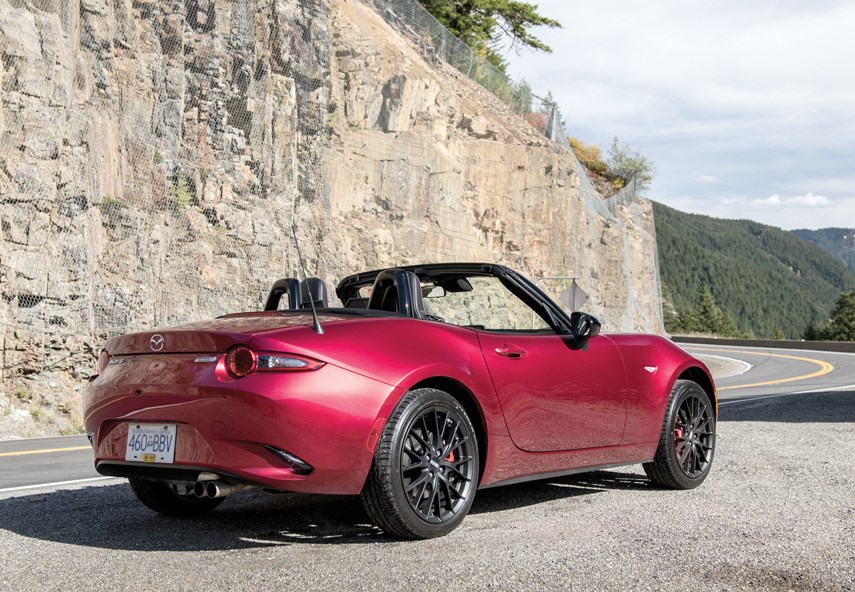It is often said that they don’t make ‘em like they used to.
Cars today are larger, heavier, more complex. Generally speaking, they’re faster and safer too, but at an overall cost of a lack of character.
It’s a little like air travel. Once upon a time, flying somewhere felt like an adventure – just you and your little craft framed against a sky filled with possibilities. Now you curse the guy next to you for hogging the armrest and try to ignore the kidney-pummelling you’re getting from the rambunctious kid behind you.
However, there is at least one company that still knows how to make a car that hews to some old-fashioned ideals. This year, the MX-5 saw a not-inconsiderable bump in horsepower, but the added zip came neither from turbocharging nor hybridization. Instead, the company’s engineers carefully balanced and honed engine components, helping this little car breathe better.
Even so, the market marches steadily toward high-riding crossovers that exploit horsepower and clever differentials to bend physics. The MX-5 could well be one of the last chances to drive a car built for, well, drivers. Let’s have a look to see if Mazda’s perfected their recipe.
Design
The original Miata is, and remains, one of the friendliest-looking cars on the road. Just pop up those headlights and you want to do nothing more than chuck it under the chin and feed it a dog biscuit.
By comparison, the new MX-5 is a fierce-looking little thing, with more than a few elements of reptilian menace about its narrow-headlight gaze. There’s also something not quite right about how the rear sits up in the air.
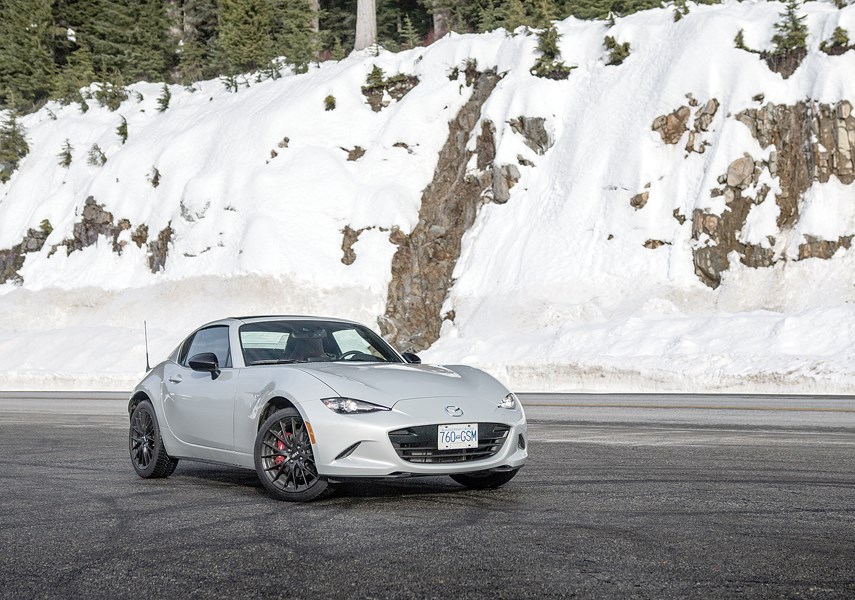
Leaving these mild criticisms aside, what a lively-looking little car. Get the colour right, and the way the paint work seems to flow over the door sills and into the interior is a wonderful treat. Incredibly, the fourth generation MX-5 is actually smaller than the original.
Sixteen-inch alloys are standard, with 17-inch the maximum you can get on the two higher trims. The only thing I’d really wish for here is a proper British Racing Green paint option.
Environment
From first to second to third generation, the MX-5 grew ever larger and more comfortable. The third-gen in particular is a reasonably spacious machine for such a small footprint. Cost considerations forced Mazda to design the chassis in tandem with the larger 2+2 RX-8, with the result that the third-gen cars aren’t cramped for taller drivers.
Dialling things back on the size-o-meter has resulted in a cockpit that’s going to require compromises from drivers. The cup holders are a bit of an afterthought, the overall space is a little tight, and the fixed-top RF versions are downright claustrophobic.
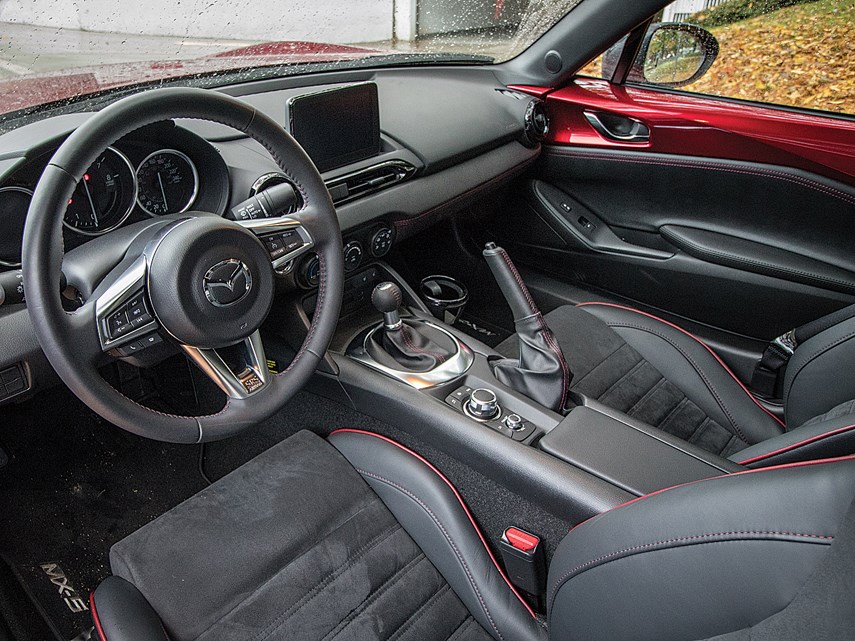
Having said that, there’s a level of focus here that you’d wish other manufacturers could bring to bear. If you fit, the MX-5’s seats are comfortable over longer distances, and the level of engineering put into the ergonomics keeps fatigue at bay.
Space is at a bit of a premium, and you’d better be good at Tetris if you want to pack the smallish trunk for a weekend away.
Performance
The MX-5 was never a numbers car, more a vehicle designed around a delightful feel. For what it’s worth, the new engine displaces 2.0 litres and makes 181 horsepower at 7,000 r.p.m. and 151 foot-pounds of torque at 4,000 r.p.m.
Under instrumented testing, publications like Car and Driver have clocked the soft-top MX-5 to 100 kilometres per hour in under six seconds and through the quarter-mile in 14.5 seconds. That’s roughly as quick as a VW GTI – none too shabby.
However, where the MX-5’s new engine really charms is in its willingness to rev quickly, and the way the power comes on as you get higher up in the rev range. Wringing that 2.0-litre four-cylinder out is now nearly 30 h.p. more satisfying than the previous one, and while it’s not that much faster on paper, it feels just a little bit more special.
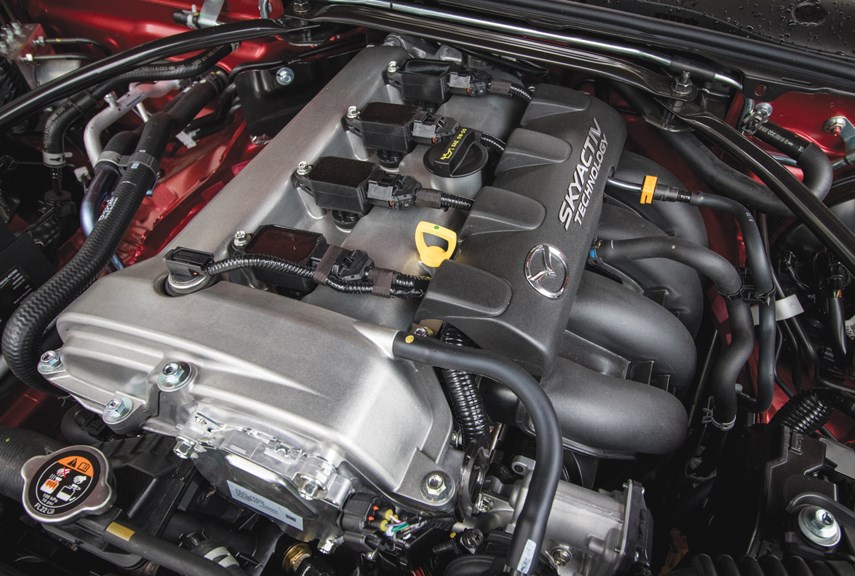
And then there’s all the good MX-5 stuff we already loved. The suspension is a little softer than you’d expect, but that’s a little old-school as well. You can feel the car leaning into the corners, and better understand how weight transfer is affecting your grip. I can think of no better machine to learn the physics of performance driving at your local racing track.
Plus, with a curb weight of around 1,070 kilograms (for the lighter roadster), the MX-5 has enough grip so you won’t be holding anyone up on the track. No longer is this car an example of the old adage, “It’s more fun to drive a slow car fast than a fast car slow.” Instead, the MX-5 is properly quick, with ample grip and power.
And yet it’s still not too much. In a V-8 Mustang, you’re always keeping a firm grip on the reins, as the speed limit feels like a major restriction. The MX-5’s humble torque levels mean that you do need to rev it up a bit, and can do so without being social.
If you can live with the interior compromises, it’s just a really well balanced car. The added power hasn’t harmed things one bit, only made the decision between soft-top roadster or folding hard-top RF that much more difficult. I’d recommend the roadster primarily, but the RF is certainly pretty, and a little quieter for everyday use.
Features
At $32,900 to start, up to $42,900 for a GT-class RF, the MX-5 is not exactly cheap and cheerful. The original was a little more affordable to the average user. Still, this is Jaguar F-Type styling and fun-to-drive levels for VW GTI prices.
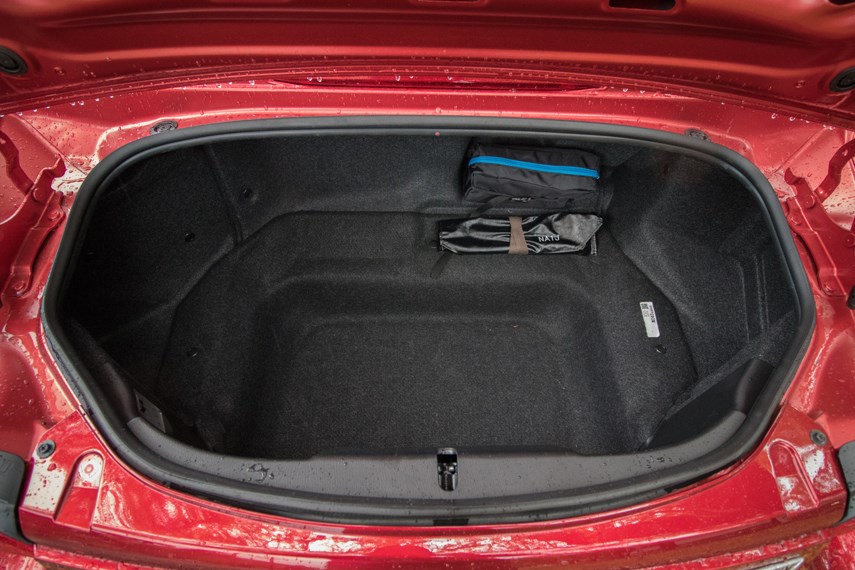
The infotainment now supports Apple CarPlay and Android Auto, though it is getting a little dated-looking. Functionality is acceptable, and playing Bluetooth calls through speakers mounted in the headrests helps out with the considerable cabin noise.
Fuel economy figures are hugely improved from the third-generation car, at 9.0 litres/100 kilometres in the city, and 7.0 l/100 km on the highway. Even with more spirited driving, the MX-5 returns consistently economical results. However, note that premium fuel is required.
Green light
Light and lively; added power is a bonus; not overstyled.
Stop sign
Interior space compromises; limited colour palette.
The checkered flag
A little old-school two-seater charm, with all the modern conveniences.
Competition
Fiat 124 Spider ($31,495): Would a rose by any other name smell as sweet? Well, perhaps not. The Fiat 124 is basically an MX-5 underneath (it’s even built in Hiroshima), but comes with unique styling and the option of a turbocharged engine.
Viewed in isolation, it’s a pretty decent car, and good fun to boot around with a little added turbo torque. However, measure it up against the MX-5, and the original just feels better engineered, and more carefully balanced. The 124 is the better top-down city cruiser, the MX-5 the one that’ll have you playing hooky from work so you can drive up to Lillooet for lunch.
